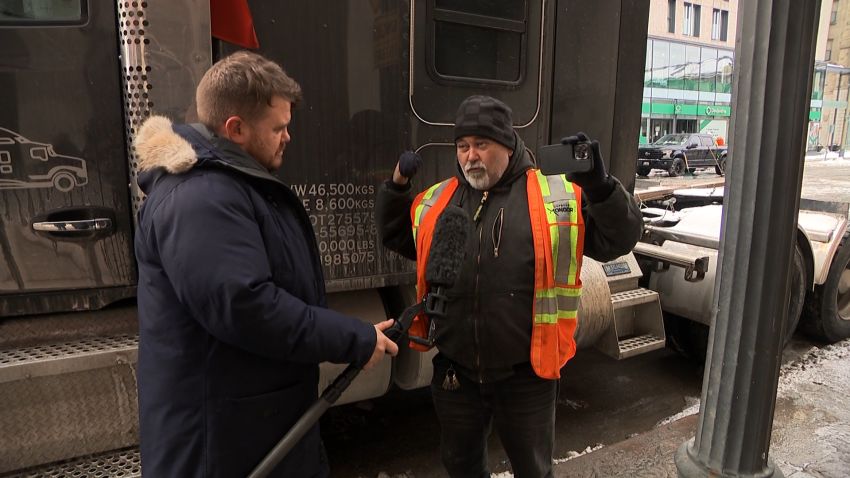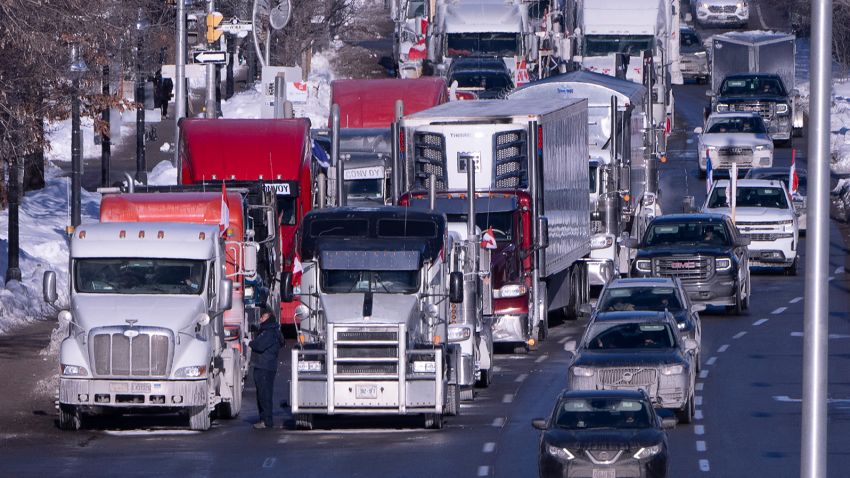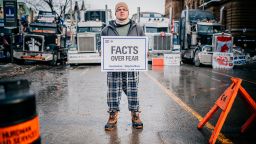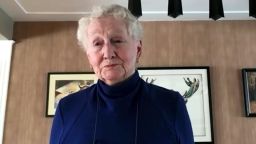Access to three border crossings in Michigan, North Dakota and Montana have been cut off by truckers and like-minded demonstrators on the Canadian side of the border who are protesting Covid-related restrictions.
To address the ongoing issue, the Canadian government announced Thursday it would send additional officers and resources to protests throughout the country.
“The plan is to make sure police have all the resources they need,” said Marco Mendicino, the public safety minister. “Our top priority is to make sure that these illegal blockades end.”
Prime Minister Justin Trudeau said late Thursday the blockades were “hurting jobs, businesses, and our country’s economy.”
For two weeks now, the trucks have blockaded the downtown core of Ottawa, the capital of Canada. In recent days, demonstrators have parked their bulky vehicles in the middle of critical roadways between Canada and the US.
Thursday marked the fourth day protesters impeded access to the Ambassador Bridge, which connects Detroit and Windsor – the busiest international crossing in North America.
Secondly, a mix of semi-trailers and farm equipment shut down the border crossing connecting Emerson, Manitoba, and Pembina, North Dakota, according to the Royal Canadian Mounted Police in Manitoba. And thirdly, the Coutts access point between Alberta and Montana has also been blocked.
The protests were ignited by truckers who oppose the nation’s new rule that requires them to be fully vaccinated when crossing the Canada-US border or face a two-week quarantine. Their “Freedom Convoy” has since drawn others who are resisting Covid-19 preventative measures, including mask mandates, lockdowns and restrictions on gatherings.
“I want all these mandates gone, and I’m not leaving until all the mandates are gone. So, I am here for the long haul,” Dylan Friesen, a protester in Ottawa, told CNN on Wednesday. “They can try get rid of us, but we’re not leaving.”
But officials are taking legal steps to remove the demonstrations.
How officials are responding
The blockades have slowed the movement of goods and caused production issues at a number of car manufacturing plants along the border. Ford, General Motors and Stellantis all announced production issues due to the blockade.
Further, about 60 to 70 vehicles were attempting to disrupt traffic at Ottawa International Airport on Thursday by circling the arrivals and departure terminals, the airport said in a statement. Videos on social media showed a handful of vehicles driving around near a street close to the airport carrying Canadian flags and honking.
The mayor of Windsor, Ontario, told CNN on Thursday that city leaders will be in court Friday to seek an injunction against the protestors.
If the protestors are “unwilling to move on,” the mayor said tow trucks and equipment would be brought in to help “move the vehicles out of the way” to reopen the border crossing.
“Because it is too essential to both of our national economies, and the livelihood of this border crossing puts, the importance of this border crossing puts a lot of bread on the table for our families on both sides of the border,” Mayor Drew Dilkens told CNN’s Laura Coates.
And if the protesters don’t want to leave, the injunction – if granted– will expand police’s authority on how they may respond, he explained.
“I get that this injunction would be a single piece of paper, but it gives police more weight in the actions that they are prepared to take, and they will do what is operationally required to move people out.”
Trudeau said Thursday he spoke with Dilkens to help contain the situation “because it is causing real harm to workers and economies on both sides of the border.”
Still, Dilkens acknowledged resolving the standoff is a delicate operation. Forcibly removing the truckers could cause even more problems.
“It’s very frustrating because people just want us to go in and flush everyone out, and there’s a real threat of violence here. We’ve seen protesters come out with tire irons when the police attempted to tow a car. It could escalate very, very quickly,” he said.
“At the same time, going in and moving out 100 or 200 protesters – well, we could probably do that. What we don’t want to see happen is have 300 more show up tomorrow to replace the ones that were moved out. So, police are trying to negotiate.”
Ottawa police said on their website that there have been 25 arrests since protests began about two weeks ago and more than 1,500 tickets have been issued for traffic, noise and other violations.
Plus, the city’s police chief Peter Sloly said a company that could move the trucks has been threatened.
“At least one of the major tow trucks (company) that would have been able to supply us with the logistics to tow illegal vehicles and to a significant degree reduce the size of the demonstrations has been threatened themselves,” he said. “They have been threatened through some sophisticated online activities and direct threats to harm to their employees and their business.”
He added that authorities might try other options.
“We are considering other methods that may allow us to not need to use tow trucks to the extent we initially thought,” he said. “All options are on the table.”
A criminal investigation into the threats is underway, Sloly said.
Similar protests could take place on the other side of the border. American officials are warning that rallies soon could happen in the United States, where right-wing media outlets have raised that prospect and offered positive coverage of the protests. Sunday’s Super Bowl in Southern California could draw such crowds, the officials said.
What the protesters are demanding

The protesting truckers represent a vocal minority among their profession and fellow citizens.
Canada has one of the highest vaccination rates in the world, with about 4 in every 5 Canadians fully vaccinated, according to data from Johns Hopkins University. Nearly 90% of Canada’s truckers are fully vaccinated and eligible to cross the border, according to the government.
Friesen, the protesting trucker, was let go from a job at a transport company in Ontario for not taking the Covid-19 vaccine, he explained.
“That’s not right for companies be able to decide that and take away our right to earn money and support our livelihood,” Friesen said.
Samuel Gauthier, who supports the truckers protesting in Canada, is unvaccinated, which has prevented him accessing certain businesses in his home province of Quebec, he told CNN.
“I can’t go skiing, I can’t go to Walmart, I can’t go to Canadian tire, I can’t go to Home Depot, I can’t go to restaurants, I can’t go to bars, I can’t go to the gym,” Gauthier said, noting restrictions in Quebec have been “a bit more intense than in other places in Canada.”
The protesters’ many different requests make the negotiations tricky, Dilkens said.
“I would call them a leaderless group, and frankly, the requests that these folks have, they are not unified,” he said. “There are folks here protesting government, like you’d see at a G-7 or G-20 protest. There are folks that are protesting climate change initiatives, and there are some folks who protesting vaccine mandates.”
Meanwhile, officials are pressing demonstrators to stop blocking the critical pathways.
“I’ve said consistently, we welcome the freedom of people to protest lawfully and peaceful, but this is not a lawful protest,” Alberta Premier Jason Kenney said during a news conference this week.
CNN’s Paradise Afshar, Josh Campbell, Tanika Gray, Jason Hanna, Chris Isidore, Chuck Johnston, Paul P. Murphy, Donie O’Sullivan, Raja Razek and Geneva Sands contributed to this report.




